GODS
|
Bloodfather, the Unsatisfied Questioner, the Bloodspiller
|
Portfolio:
|
Inquiry, necromancy, death |
|
Alignment:
|
Neutral Evil |
|
Domains:
|
Knowledge, Evil, Deathbound, Undeath |
|
Favored Weapon:
|
Short sword |
|
Symbol:
|
Scarlet droplet |
|
Worshipers:
|
Necromancers, evil wizards, inquisitors, torturers |
|
Home Plane:
|
Carceri |
The unquenchable Afflux seeks knowledge of blood, body, and mind. Afflux never flinches from sacriflcing the living to understand what made them
once alive. He is the lord of interrogation, torture, and execution, as well as the knowledge gained thereby. He appears as a hairless, bloodsoaked
man of pale flesh and supernaturally bloodshot eyes. He wears a great coat of blood that constantly drips and flows but never runs dry. His home
plane is Carceri, and his symbol is a scarlet droplet.
Necromancers, evil wizards, inquisitors, and torturers revere Afflux. All followers of Afflux see members of good-aligned faiths, especially those
that claim to offer knowledge, as their enemies. Among the evil deities, Afflux has no special foes, and his followers may sometimes enter alliances
of convenience with other evil churches when their goals intersect.
Afflux teaches that every creature has a secret, no matter how mundane, and the best way to spill that secret is along with the creature’s
blood. To search eternally for knowledge is a noble quest, but the best place to search is in the tissues of the living, dead, and undead, since the
secrets of sentience and animation mask the real secret of ultimate understanding.
Sometimes evil wizards come to at least revere, if not worship, Afflux. Certainly his name is known among necromancers, whose grisly researches
are so similar to Afflux’s prescribed methods. Torturers and others who delight in the physical pain visited on others pay the Unsatisfied
Questioner frequent homage.
The prayers offered up to Afflux resemble the sounds of the victims put on the rack by the god’s ordained torturers. Each scream is a
mantra, and a night of pain is a solemn mass.
Afflux has few temples. Any necromancer’s lab where the methods of the Bloodspiller are utilized can become a shrine to Afflux if the space
is hallowed in his name. Rites: When a victim succumbs too quickly to pain, it is customary for the presiding cleric to wound himself in
Afflux’s name (if the cleric is living), to offer some additional pain as recompense.
Afflux generally sends a wheep as a herald. His planar allies are ravids, night hags, and nightwings.
|
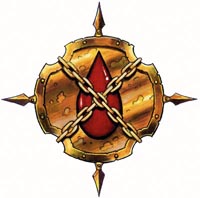 |
|
Messenger of Io
|
Portfolio:
|
Learning, invention, pleasure |
|
Alignment:
|
Chaotic Neutral |
|
Domains:
|
Chaos, Charm,
Dragon, Illusion,
Luck, Trade ,
Travel, Trickery |
|
Favored Weapon:
|
Scimitar or Claw |
|
Symbol:
|
Grinning dragon�s head |
|
Worshipers:
|
Chaotic dragons, free thinkers |
|
Home Plane:
|
Outlands |
Aasterinian is a cheeky deity who enjoys learning through
play, invention, and pleasure. She is Io�s messenger, a Huge
brass dragon who enjoys disturbing the status quo.
Aasterinian is flighty and quick-witted. She encourages
her followers to think for themselves, rather than relying
on the word of others. The worst crime, in Aasterinian�s eyes,
is not trusting in yourself and
your own devices.
Aasterinian�s clerics are
typically wanderers who
travel in disguise or
secrecy. Temples to the
goddess are rare in the
extreme, though simple
shrines dot the landscape�quiet,
hidden places where worshipers can rest
peacefully on their travels.
Her followers enjoy friendly relations
with those of Garl Glittergold, Fharlanghn, Olidammara,
and similar deities.
|
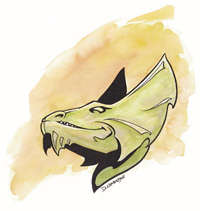 |
|
The Acquisitor, Hoardmistress
|
Portfolio:
|
Acquisitiveness, status, wealth |
|
Alignment:
|
True Neutral |
|
Domains:
|
Cavern, Dragon, Metal,
Protection, Wealth |
|
Favored Weapon:
|
Scimitar or Claw |
|
Symbol:
|
A twelve-faceted gem |
|
Worshipers:
|
Dragons, those who seek wealth |
|
Home Plane:
|
Outlands |
Astilabor represents the natural
draconic desire to acquire
treasure and power. She dislikes
the naked greed displayed by
Tiamat and her followers.
Astilabor values wealth and power, but without any stigma of greed. She instills in dragonkind the innate
need for collecting and protecting the hoard. She claims that
she cannot abide thievery of any kind from her worshipers,
but often turns a blind eye if such acts are performed in the
name of building one�s hoard.
Astilabor accepts only clerics with a neutral aspect to their
alignments, the better to remain pure to the goal of acquiring
and protecting the hoard. Her clerics prefer not to get
involved in conflicts between dragons, but often reward
those whose hoards become large and valuable.
Astilabor is revered by dragons of all types and alignments,
but actively worshiped by few. Most at least scratch
out her symbol as a protective ward over their hoards.
Astilabor�s worshipers are friendly toward those of
Moradin and Garl Glittergold (since those gods respect
the value of a gem or coin as much as anyone), but they
distrust followers of Olidammara, whom they believe
to be thieves at heart.
|
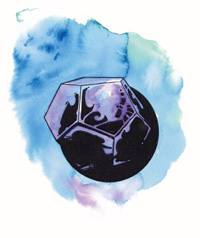 |
|
The Platinum Dragon, King of the Good Dragons, Master of the North Wind
|
Portfolio:
|
Good dragons, wind |
|
Alignment:
|
Lawful Good |
|
Domains:
|
Air, Cold, Good, Luck, Nobility, Protection,
Storm |
|
Favored Weapon:
|
Claw |
|
Symbol:
|
Star above a milky nebula |
|
Worshipers:
|
Good dragons, anyone seeking protection from evil dragons |
|
Home Plane:
|
Celestia |
Bahamut (bah-hahm-ut) is revered in many locales. Though all good dragons pay homage to Bahamut, gold, silver, and brass dragons hold him in
particularly high regard. Other dragons, even evil ones (except perhaps his archrival Tiamat), respect Bahamut for his wisdom and power.
In his natural form, Bahamut is a long, sinuous dragon covered in silver-white scales that sparkle and gleam even in the dimmest light.
Bahamut’s catlike eyes are deep blue, as azure as a midsummer sky, some say. Others insist that Bahamut’s eyes are a frosty indigo, like
the heart of a glacier. Perhaps the two accounts merely reflect the Platinum Dragon’s shifting moods.
Bahamut is stern and very disapproving of evil. He brooks no excuses for evil acts. In spite of this, he is among the most compassionate beings in
the multiverse. He has limitless empathy for the downtrodden, the dispossessed, and the helpless. He urges his followers to promote the cause of
good, but prefers to let beings fight their own battles when they can. To Bahamut, it is better to offer information, healing, or a (temporary) safe
refuge rather than to take other’s burdens upon oneself.
Bahamut is served by seven great gold wyrms that often accompany him or one of his avatars.
Bahamut has few clerics and even fewer temples. He accepts only good clerics. Clerics of Bahamut, be they dragons, half-dragons, or other beings
attracted to Bahamut’s philosophy, strive to take constant, but subtle action on behalf of good, intervening wherever they are needed but
striving to do as little harm in the process as possible.
Many gold, silver, and brass dragons maintain simple shrines to Bahamut in their lairs, usually nothing more elaborate than Bahamut’s symbol
scribed on a wall.
|
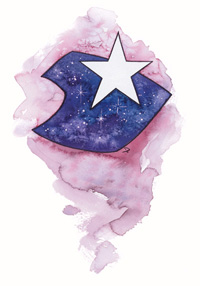 |
|
The Uncaring, Lord of All Magics, Archmage of the Deities
|
Portfolio:
|
Magic, arcane knowledge, balance and foresight |
|
Alignment:
|
True Neutral |
|
Domains:
|
Knowledge, Magic, Mind,
Oracle, Planning, Trickery |
|
Favored Weapon:
|
Quarterstaff |
|
Symbol:
|
Eye balanced on a pedestal inside a pentagon |
|
Worshipers:
|
Wizards, sorcerers, illusionists, philosophers, sages |
|
Home Plane:
|
The Outlands |
The deity of magic, Boccob (bock-obb), appears as a handsome man of indeterminate age clad in loose purple garments. Shimmering golden runes that
move and change cover his attire. He has few followers, but this fact does not seem to concern him in the least.
Boccob is a distant deity who promotes no special agenda, except proclaiming magic the most important force in the world—more vital than
good, evil, law, or chaos. Most of his clerics observe strict neutrality. One missal advises Boccob’s followers to seek balance above good,
evil, law, or chaos and to push back encroachments of good or evil.
This steadfast moderation in political, ethical, and philosophical affairs earns Boccob and his followers few friends. Nevertheless,
Boccob’s worshipers are respected for their knowledge and magical prowess, and their advice is valued (if not always completely trusted).
Boccob’s clerics favor purple garments with gold trim; many are cleric/wizards or cleric/sorcerers. Most remain aloof from worldly affairs
and devote themselves to magical research and to formulating prophecies. They share their knowledge of the future only sparingly, lest someone get
the upper hand and upset the balance. Boccob’s clergy actively creates magic items, which they usually sell to anyone with the cash to buy
them. During war, Boccob’s clerics happily sell magic items to all sides. Many of Boccob’s clerics keep busy rooting out bits of magical
lore, recovering lost magic items, and investigating mysteries. They adamantly oppose any attempt to destroy a magic item or any magical place.
Boccob’s temples are usually located in urban areas. The are always well fortified to withstand outside interference, and they house
extensive libraries. Most are also well equipped with various scrying devices. The clergy use them to spot infiltrators and keep an eye on the
surrounding area.
Visitors to a temple of Boccob usually get a cool greeting at best and are never truly welcomed unless they have some unusual magic item to offer
for examination or money to spend on spells, magic items, or information.
|
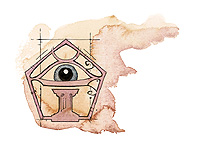 |
|
The Silent, The Watcher
|
Portfolio:
|
Fate, death, judgment |
|
Alignment:
|
True Neutral |
|
Domains:
|
Death, Dragon, Fate,
Knowledge, Planning, Time |
|
Favored Weapon:
|
Scythe (claw) |
|
Symbol:
|
An unblinking draconic eye |
|
Worshipers:
|
Dragons, those who would observe |
|
Home Plane:
|
Outlands |
Chronepsis is neutral�silent, unconcerned, and dispassionate.
He is the draconic deity of fate, death, and judgment. His form
is colorless and without luster, marking
him as an outsider to the struggles of the chromatic and
metallic dragons.
Chronepsis is a passionless observer of the
world. He passes judgment on all dragons
when they die, deciding where
their souls go in the afterlife.
Unlike Lendys,
Chronepsis is uninterested in
justice: he merely observes
what is and is not. He is also
singularly uninvolved in
the activities of the living,
and strives to remain so. It
is said that only a cataclysm
of world-shaking proportions
could rouse Chronepsis from
his disinterest.
Chronepsis has very few active worshipers and even fewer clerics, since most
dragons don�t possess the balanced outlook to avoid
interfering in the events they observe.
The followers of Chronepsis count other faiths neither as
allies nor enemies. Of the other deities, only Boccob the
Uncaring shares a similar outlook, but neither deity cares
enough to forge an alliance.
|
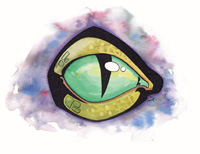 |
Corellon Larethian
|
Greater Diety
|
Creator of the Elves, The Protector, Protector and Preserver of Life, Ruler of All Elves
|
Portfolio:
|
Elves, magic, music, arts, and war |
|
Alignment:
|
Chaotic Good |
|
Domains:
|
Chaos, Community, Good,
Protection, War |
|
Favored Weapon:
|
Longsword |
|
Symbol:
|
Silver crescent moon |
|
Worshipers:
|
Elves half-elves, bards |
|
Home Plane:
|
Arborea |
The deity of elves, Corellon Larethian (core-eh-lon lah-reth-ee-yen), usually appears as an androgynous elf clad in a sky-blue cloak and armed
with a longbow and longsword. He also wears a large, circular amulet that bears his crescent moon symbol. He has a lithe and swift look about him,
and his movements are both swift and graceful.
Corellon Larethian is the creator and protector of the elven race. He governs those things held in highest esteem among elves, such as magic,
music, arts, crafts, poetry, and warfare. Gruumsh, the deity of orcs, is his nemesis, and it is because of Corellon’s battle prowess that
Gruumsh is called “One-Eye.”
Corellon concerns himself with all aspects of elven welfare. He also remains alert to any taint of evil among the elves, and he seeks to stamp out
any evil influence the moment it appears. Corellon played a leading role in the schism that ultimately resulted in the banishment of the drow
underground.
Corellon spurs his people toward self-reliance, vigilance against danger, and appreciation of the world’s beauty. It is Corellon’s
influence that leads elves to study magic and swordplay for the duration of their long lives, to serve as guardians and caretakers of the forests,
and to appreciate aesthetic pleasures in spite of their warrior heritage.
Corellon’s clerics often wear blue cloaks. They serve as leaders, teachers, diplomats, and generals in elven communities. They train others
in the arts of combat and magic while honing their own skills, and they serve as mediators in any disputes that may arise from the elves’
independent lifestyle. They usually seek to maintain cordial relations with other good, sylvan creatures.
Corellon’s temples can be located anywhere elves live, usually in sylvan woodlands. Though always beautiful and designed to blend in with
the surrounding landscape, they are invariably both sturdy and defensible. They are often placed on hilltops, river crossings, and other locations of
strategic significance. Living plants or trees are always included in a temple of Corellon, either as decoration as part of the structure.
|
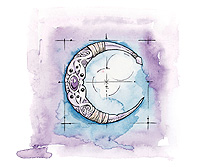 |
|
King of the Ghouls
|
Portfolio:
|
Necromancy, ghouls |
|
Alignment:
|
Chaotic Evil |
|
Domains:
|
Chaos, Evil, Hunger |
|
Favored Weapon:
|
Scimitar |
|
Symbol:
|
Ghoul skull |
|
Worshipers:
|
Ghouls |
|
Home Plane:
|
Abyss |
The insatiably hungry Doresain appeals to all creatures whose hunger can never be appeased. The deity looks like an especially thin and wasted
ghoul. He has eyes ablaze with a sickly green ghoul-light, and his feet are hooflike. In contrast with Doresain’s wasted body, he wears an
elegant white cloak of supple man-flesh over pale leather armor studded with tiny skulls. Ghouls are the primary worshipers of Doresain, and his
symbol is a ghoul skull.
Though the King of the Ghouls is a powerful entity himself and controls his own layer of the Abyss, he was once a vassal of Orcus. Later,
Yeenoghu’s gnoll host invaded, and the King of the Ghouls was forced to swear fealty and pay homage to Yeenoghu. Yeenoghu subsequently lost
control of the King’s layer, and more recently, Yeenoghu has lost the ability to command the King.
The King of the Ghouls teaches that to exist is to eat. A fully experienced existence requires the consumption of prey, preferable sentient. Flesh
for sacrifice is dear to the King. When life is quenched under tearing teeth and quivering lips, the eater can finally feel true happiness, at least
for a time.
Doresain sometimes makes an appearance when incautious necromancers meddle with the Negative Energy Plane. Taking such meddling as an invitation,
the King appears and forcibly converts all those present to ghouls, often thereby creating new worshipers for himself. While many ghouls are ignorant
and godless, those that find religion invariably discover the King of the Ghouls. Creatures other than ghouls that come to worship the King do so
with the knowledge that they will be “drawn into the fold” sooner rather than later.
All ghouls pay homage to the King. Ghoul lore hearkens back to a land sacred to ghouls called the White Kingdom. Though ghouls bound to the mortal
plane sometimes create lesser versions of what they believe the White Kingdom to be, it is accepted that the true incarnation of the White Kingdom
can be found on the layer of the Abyss where the King rules.
Sharing the sweet flesh of a victim among several ghouls is informally called “passing it around the horn,” and serves as a common
rite in remembrance of Doresain. Each gluttonous act of consumption is, in its way, a prayer to Doresain, even if the eater doesn’t know
it.
Temples to the King of the Ghouls are found only underground. Small shrines can sometimes be found in underground mausoleums or at the
catacomb’s center, but fully functioning temples are erected only in the deepest subterranean realms, surrounded by a community of ghouls the
size of a small city (at least).
Doresain often sends a gravetouched ghoul 13th-level barbarian as his herald. His planar allies are gravetouched ghoul succubus demons,
gravetouched ghoul erinyes devils, and gravetouched ghoul ice devils. Doresain has the power to add the gravetouched ghoul template (see page 103) to
creatures to which the template is normally not applicable.
|
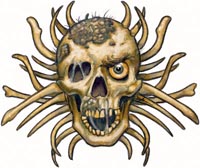 |
Ehlonna
|
Intermediate Diety
|
Ehlonna of the Forests, Goddess of the Woodlands
|
Portfolio:
|
Forests, woodlands, flora & fauna, and fertility |
|
Alignment:
|
Neutral Good |
|
Domains:
|
Animal, Celerity, Good,
Plant, Sun |
|
Favored Weapon:
|
Longbow |
|
Symbol:
|
Rearing unicorn |
|
Worshipers:
|
Elves, gnomes, half-elves, halflings, rangers, druids, hunters, farmers |
|
Home Plane:
|
Beastlands |
Ehlonna (eh-loan-nuh) sometimes appears as a raven-haired human and sometimes as an elf with golden tresses. Her garb varies, ranging from the
serviceable clothing of a forester or ranger to the delicate gown of an elven princess, but it is always pale green. Ehlonna watches over all good
people who live in the forest, love the woodlands, or make their livelihood there.
Ehlonna watches over all good people who live in the forest, love the woodlands, or make their livelihood there. She likewise protects forests and
woodlands from destruction or overuse.
Ehlonna exhorts her followers to live in harmony with their woodland homes, taking only what they need. The bounty of the forest, Ehlonna teaches,
is a gift to be cherished and appreciated, not a treasure to be coveted or looted.
Ehlonna’s clerics usually choose serviceable attire of forest green. They live in forests and keep on friendly terms with the local rangers,
druids, elves, and fey. They keep guard against encroachments by evil folk, loggers, and others who would exploit and ruin any woodland. When
confronting anyone who would despoil a forest, they tend to be gentle but firm, at least at first. If the invaders persist, Ehlonna’s clerics
can be ruthless in driving them out. Many of Ehlonna’s clerics take it upon themselves to teach woodcraft, plant trees, or both.
Woodland temples to Ehlonna are often open-air affairs with only trees for a roof. Small shrines to her are occasionally found in forest
villages.
|
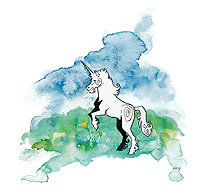 |
Erythnul
|
Intermediate Diety
|
The Many
|
Portfolio:
|
Hate, envy, malice, panic, ugliness, and slaughter |
|
Alignment:
|
Chaotic Evil |
|
Domains:
|
Chaos, Evil, Madness,
Trickery, War |
|
Favored Weapon:
|
Morningstar |
|
Symbol:
|
A half-demon, half-boar mask |
|
Worshipers:
|
Barbarians, fighters, rogues, looters, outlaws |
|
Home Plane:
|
Pandemonium |
The deity of slaughter, Erythnul (eh-rith-null), is a terrible sight to behold. He usually appears as a human with knotted muscles and a blocky
frame. His skin is mottled and ruddy, almost as though blood oozes from his pores. In battle, his features change between human, gnoll, bugbear,
ogre, and troll. This mutable form is reflected in his title, The Many. He wields a two-handed morningstar in battle. This weapon has a perforated
stone head that makes frightening sounds whenever Erythnul swings it.
Erythnul is a brutal deity who delights in panic and slaughter. In civilized lands, his followers (including evil fighters, barbarians, and
rogues) form small, criminal cults. In savage lands, evil barbarians, gnolls, bugbears, ogres, and trolls commonly worship him.
Erythnul admonishes his followers to shed blood for its own sake, to covet what is not theirs, and to destroy anyone who would deny them anything.
He further urges them to bring ugliness and strife to pleasant locales.
To take something away from someone else—especially from a rival—is an exalted act in Erythnul’s eyes. Foes who cannot be killed
should be maimed, and that which cannot be stolen should be destroyed.
Erythnul’s clerics favor rust red or bloodstained garments. They are cruel, sadistic, and hateful. They maintain a low profile in most
civilized lands. In savage areas, members of the priesthood are known as bullies and murderous tyrants. They love to deface beautiful things and to
disfigure attractive people.
Anyplace where great bloodshed or a spectacular act of cruelty has occurred is considered a holy site and an excellent place for a temple
dedicated to Erythnul. In the countryside, Erythnul’s followers build squat, unsightly fortresses in places where battles, ambushes or
massacres have occurred. In urban areas, Erythnul’s temples are usually hidden in seedy sections of cities, preferably on sites where horrible
crimes have happened.
|
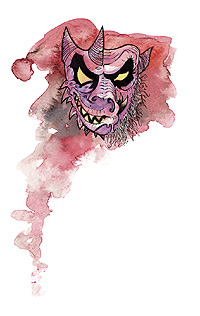 |
Evening Glory
|
Lesser Deity
|
The Deathless Beauty, the Eternal Lover
|
Portfolio:
|
Love, beauty, immortality through undeath |
|
Alignment:
|
True Neutral |
|
Domains:
|
Charm, Magic, Protection |
|
Favored Weapon:
|
Dagger |
|
Symbol:
|
A hand, pierced through the palm with a heart-shaped hole |
|
Worshipers:
|
Immortality seekers, lovers, undead |
Evening Glory teaches that love need not ever die. Instead, love may go on indefinitely, if the body’s remains are properly preserved. The
deity of love at any price, Evening Glory appears as an exquisitely preserved woman with ice-white (almost translucent) flesh and platinumwhite,
neck-length hair. She has eyes of baby blue, with lips, fingernails, and toenails the same color. She is flawless, despite (or because of) her
necrotic chill. Disdaining simple nudity, the Deathless Beauty prefers extravagant, backless gowns. A heart-shaped, oddly alluring hole completely
pierces the palm of each of her bloodless hands. Evening Glory’s symbol is an open hand, pierced through the palm with a heartshaped hole.
The Eternal Lover appeals strongly to immortality seekers, lovers, and undead. Still, anyone who has loved and lost, or knows love and fears its
end, is a potential worshiper of Evening Glory. Most who worship her are undead, or soon become undead after worshiping her for a time. Many of her
followers would rather welcome the followers of other faiths, but it is hard to welcome members of faiths that believe undeath must be
eradicated.
Evening Glory teaches that desire is all that matters, and the desire for the love of another should never be allowed to fail through the
depredations of age. Those whose love transcends life should seek life everlasting through the grace of undeath. The perfect preservation may freeze
love forever. While the resurrection of tragically slain lovers may do for some, nothing can stay old age’s imperious final call—nothing
but the embrace of undeath.
The training a cleric must undergo to become fully vested by Evening Glory is a secret cloaked in love and affection. The clerics of Evening Glory
are mainly proselytizers, preaching about the continuance of love (and, through this, the continuance of existence after death).
All prayers to Evening Glory extol her unchanging perfection, a beauty frozen at its height by the balm of death. Temples to the Eternal Lover can
show up anywhere, though when the authorities realize the true nature of the worship to this god, with its undead component, those temples are
usually banned.
The rites of Evening Glory are many, but the mere recitation of a love poem inspired by the goddess is considered a daily obligation by her
followers.
Evening Glory usually sends a female lich as her herald. Planar allies are Medium, Large, and Huge fire elementals.
|
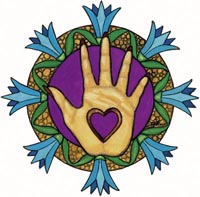 |
|
The Night Dragon
|
Portfolio:
|
Decay, undeath, exhaustion |
|
Alignment:
|
Neutral evil |
|
Domains:
|
Darkness, Death, Dragon,
Evil, Undeath |
|
Favored Weapon:
|
Scimitar or Claw |
|
Symbol:
|
Draconic skull |
|
Worshipers:
|
Evil dragons, necromancers, undead |
|
Home Plane:
|
Hades |
The terrifying Night Dragon,
Falazure, is neutral evil. He is the
lord of energy draining, undeath,
decay, and exhaustion. Some
claim he has a decaying skeletal
form, but others believe that
he looks like a decrepit black
dragon whose flesh is pulled tight
over his bones.
Falazure teaches that even a dragon�s long life span need not
be the limit to a dragon�s existence. Beyond the world of the
living is another realm, one of undeath eternal. It is generally
accepted that Falazure created (or had a hand in the creation of)
the first undead dragons, such as dracoliches,
vampiric dragons, and ghostly dragons.
Among the draconic gods, perhaps
only Bahamut and Tiamat have
more nondragon worshipers
than Falazure. Many necromancers
of all races revere
the Night Dragon, as well as
intelligent undead such as liches
and, especially, dracoliches.
Temples to Falazure are always
deep beneath the earth, cloaked
in darkness and far from the sun
and fresh air of the surface world.
The followers of Falazure count
all members of good-aligned faiths
as their enemies. They may occasionally
ally with the forces of Nerull,
but such instances are rare.
|
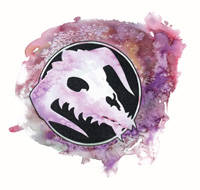 |
Fharlanghn
|
Intermediate Diety
|
Dweller on the Horizon
|
Portfolio:
|
Horizons, distance, travel, and roads |
|
Alignment:
|
True Neutral |
|
Domains:
|
Celerity, Luck, Protection, Travel, Weather |
|
Favored Weapon:
|
Quarterstaff |
|
Symbol:
|
Disk bearing a curved line with an upturned crescent above |
|
Worshipers:
|
Bards, travelers, merchants |
|
Home Plane:
|
Material Plane |
Fharlanghn (far-lahng-un), the deity of roads, appears as an elderly, weatherbeaten man with deeply wrinkled skin and sparkling eyes. He wears
nondescript clothing, usually of leather and unbleached linen. His garments are always travel-stained. He roams the roads and paths of the Material
Plane, greeting fellow travelers politely. Fharlanghn is always glad to converse, but not at any great length.
Fharlanghn is the patron of all who travel long distances, no matter what path they follow or how they’re getting there.
Fharlanghn insists that people need to move around and experience new things. The state of world is not fixed, and you never know when you might
need a new perspective or even a new home. Look to the horizon for inspiration.
Fharlanghn’s clerics travel the world, always seeking out new things. They favor simple clothing of brown or faded green. They bless
caravans (and sometimes guide them), explore new territories, scout for armies and settlers, and record long travelogues describing journeys beyond
the horizon. They also serve as translators and diplomats. Many serve as surveyors or engineers and help build roads, bridges, and ports. Still
others are involved in the manufacture of traveling gear, everything from shoes to sailing ships. No matter what their activities, Fharlanghn’s
clerics move around frequently, and a character who visits a shrine or temple more than once is likely to meet a different group of clerics there
each time.
Fharlanghn’s wayside shrines are common on well-used roads. His temples usually double as rest stops for travelers in need of shelter or
protection.
|
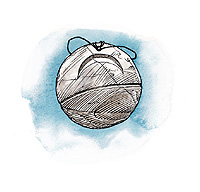 |
Garl Glittergold
|
Greater Diety
|
The Joker, The Watchful Protector, The Priceless Gem, The Sparkling Wit
|
Portfolio:
|
Gnomes, humor, and gemcutting |
|
Alignment:
|
Neutral Good |
|
Domains:
|
Community, Creation, Good, Protection, Trickery |
|
Favored Weapon:
|
Battleaxe |
|
Symbol:
|
A nugget of gold |
|
Worshipers:
|
Gnomes, illusionists, jewelers, practical jokers |
|
Home Plane:
|
Bytopia |
The deity of gnomes, Garl Glittergold (garl gliht-er-gold), appears as a handsome, golden-skinned gnome with glittering gemstones for eyes. He is
well dressed, usually in a silk jacket with long tails and silk hose. He always wears lots of gold jewelry and accoutrements. Garl Glittergold
discovered the gnomes and led them into the world. Since then, he has been their protector. He is renowned for the jokes and pranks he pulls on other
deities, though not all his victims laugh off his jests. Garl once collapsed the cavern of Kurtulmak, the deity of the kobolds. Since then, the two
deities have been sworn enemies.
Garl promotes a doctrine of practicality tempered with humor. Ignorance and complacency are dangerous, warns Garl, and he urges his people to
explore not only the world around them but new ways of doing things. Garl also emphasizes brains over brawn, and he teaches that befuddling or
embarrassing a foe can be just as complete a victory as slaying or capturing that foe.
Garl’s clerics serve as guardians and teachers in gnome communities. They maintain careful vigilance against hostile races (particularly
kobolds), and they instruct the young using a mixture of earthy practicality spiced with humor. This approach, they say, keeps the young entertained
and makes their learning all the better.
Garl’s clerics also keep extensive archives of illusion spells (usually in the form of spellbooks and scrolls), practical jokes, trap
designs, and stories. The longer and more outlandish the tale, the better, say the clerics, though not everyone agrees. Like their patron,
Garl’s clerics favor gold jewelry.
Garl’s clerics build few temples, preferring instead to place modest shrines and chapels wherever gnome dwell or congregate. These
sanctuaries are always built so they are easy to secure against hostile forces, and the clerics fill them with beautiful things. The shrines also
usually include at least one trap designed to plague unwelcome visitors. These devices are seldom fatal and often whimsical.
|
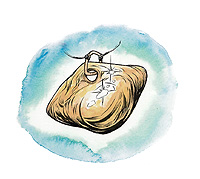 |
|
Firelord, All-Destroyer, Cleanser of Worlds
|
Portfolio:
|
Fire, destruction, renewal |
|
Alignment:
|
Chaotic evil |
|
Domains:
|
Chaos, Destruction, Dragon,
Evil, Fire, Renewal |
|
Favored Weapon:
|
Sickle or Claw |
|
Symbol:
|
Reptilian eye superimposed over a flame |
|
Worshipers:
|
Dragons, sorcerers, warlords, some druids |
|
Home Plane:
|
Pandemonium |
Garyx the All-Destroyer symbolizes the
sheer power and destructive force of
dragonkind. Some argue that Garyx is
actually insane, as a result of his long
occupation of the Windswept Depths of
Pandemonium. He appears much like a
great wyrm red dragon.
Garyx teaches by example,
periodically traveling to the
Material Plane to wreak
unholy swaths of destruction
across the landscape.
Those who revere him
follow this example, using
their power to bring ruin and
devastation.
Garyx pays little or no attention to his clerics and worshipers,
but they care not. They believe that he grants them
the power to perform acts of destruction, and that is enough.
Perhaps curiously, some druids also revere the renewal
aspect of Garyx, knowing that some devastation is always
necessary for rejuvenation to occur. Some within the Cult
of Ashardalon believe that the great wyrm is
actually an avatar of the god Garyx.
Few temples to Garyx are known to exist, though his worshipers
often carve his symbol near their handiwork.
Garyx shares traits in common with Kord and Erythnul,
but has no interest in alliances.
|
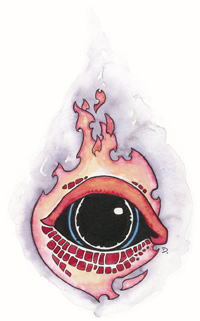 |
|
One-Eye, He-Who-Never-Sleeps
|
Portfolio:
|
Orcs, war, and territory |
|
Alignment:
|
Chaotic Evil |
|
Domains:
|
Chaos, Evil, Domination,
Strength, War |
|
Favored Weapon:
|
Spear |
|
Symbol:
|
Empty eyesocket |
|
Worshipers:
|
Orcs, half orcs |
|
Home Plane:
|
Acheron |
Gruumsh (groomsh), deity of orcs, is chaotic evil. He appears as a hulking orc in black full plate armor. He has one unblinking central eye. He
harbors a special hatred for Corellon Larethian, Moradin, and their followers. In ages past, Corellon Larethian put out Gruumsh’s left eye in a
fight. Some orc clerics dispute this tale, claiming that the elven deity stole the eye because he could not beat Gruumsh in a fair fight.
Gruumsh demands that his followers be strong, that they cull the weak from their numbers, and that they take all the territory Gruumsh thinks is
rightfully theirs (which is almost everything). He tolerates no sign of friendliness from his people. Unceasing warfare is his creed, though Gruumsh
does not object to simple colonization if that can be arranged.
Gruumsh dislikes everything that is not an orc or of orcish make, and he feels particularly spiteful toward elves (over the matter of his eye). He
feels equal malice toward dwarves, who contested with the orcs for control of the mountains and won; a state of affairs Gruumsh regards as strictly
temporary
Gruumsh’s clerics strive to become the war leaders of their communities or the key advisors to those leaders. They also see to the culling
of the weak and unfit. They usually wear fighting gear.
A temple or shrine to Gruumsh lies at the heart of nearly every orc community. They tend to be oppressive places full of acrid smoke and the
stench of blood. Temples and larger shrines invariably have holding cells where sacrifices to Gruumsh are kept, and many feature gladiatorial areas
as well.
|
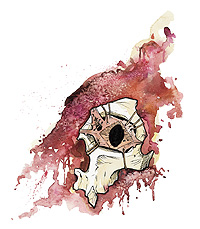 |
Heironeus
|
Intermediate Diety
|
The Invincible
|
Portfolio:
|
Chivalry, justice, honor, war, daring, and valor |
|
Alignment:
|
Lawful Good |
|
Domains:
|
Courage, Destiny, Glory, Good, Inquisition, Law, Nobility, War |
|
Favored Weapon:
|
Longsword |
|
Symbol:
|
Fist holding a lightning bolt |
|
Worshipers:
|
Paladins, fighters, monks, judges, constables |
|
Home Plane:
|
Celestia |
The deity of valor, Heironeous (high-roe-nee-us), appears as a tall human male with coppery skin, auburn hair, and amber eyes. He wears a suit of
exquisite chain mail and carries a longsword. He wages war against evil of all sorts, especially his half-brother and nemesis, Hextor.
Heironeous expects his followers to uphold the highest ideals of chivalry and justice and to treat adversity as a challenge to be met and
overcome, just as evil should be overcome. The world is a dangerous place where those who fight for justice and who protect the weak and the innocent
face a never-ending series of challenges. He exhorts his followers to act honorably at all times, and to uphold the virtues of justice and chivalry
with deeds, not just words. Those who face danger with certainty and calm will prevail against evil, Heironeous advises.
The religious hierarchy of Heironeous is organized like a military order. It has a clear chain of command, lines of supply, and wellstocked
armories.
Clerics of Heironeous fight against worshipers of Hextor whenever they can and spend the rest of their time protecting the civilized lands from
the threats of evil. Older clerics work as judges, strategists, and military instructors. The church as a whole is very militant, always championing
some cause or embarking on a crusade to against evil or injustice. Though some find their high ideals and intense devotion to their cause a little
intimidating, the church of Heironeous is widely admired. This admiration comes mostly because the followers of Heironeous battle genuine evils,
usually with little thought of monetary reward. “Glory is the reward for defeating evil, while virtue is the reward for upholding the tenets of
Heironeous,” say the clerics.
Heironeous’s clerics also oppose clerics of Hextor wherever and whenever they can.
Temples to Heironeous always have a slightly militaristic look to them. In unsettled areas, they double as fortresses. Even in settled or urban
areas they usually contain open, grassy courtyards where soldiers can train.
|
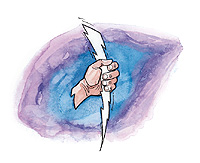 |
Hextor
|
Intermediate Diety
|
Champion of Evil, Herald of Hell, Scourge
|
Portfolio:
|
War, discord, massacres, conflict, fitness, and tyranny |
|
Alignment:
|
Lawful Evil |
|
Domains:
|
Destruction, Domination, Evil, Law, Tyranny, War |
|
Favored Weapon:
|
Flail |
|
Symbol:
|
Fist holding six red arrows |
|
Worshipers:
|
Fighters, monks, conquerors, tyrants |
|
Home Plane:
|
Acheron |
The deity of tyranny, Hextor (heks-tore), sometimes appears as a handsome man with dark hair and light skin (and he is often depicted as such in
his role as a deity of fitness). Most often he takes the form of a gray-skinned, horrible six-armed humanoid. In this form, he uses a different
weapon in each arm and wears iron scale armor with many skull decorations.
Hextor is the archfoe of Heironeous, his half brother and fellow war deity.
Hextor seeks to conquer or destroy any that oppose him. He tells his followers that the world is a dark and bloody place where the strong rule the
weak, and power is the only reward worth anything. The cruel and unrelenting pursuit of one’s goals is the only reliable path to success. Order
must be forged out of chaos and law out of anarchy. Tyranny brings order out of chaos. Dissenters must be oppressed or destroyed lest anarchy
reign.
Hextor’s sect is not as secretive as other dark religions. Temples of Hextor operate openly in many cities, and clerics wear black clothing
adorned with skulls or gray faces.
Hextor’s clerics constantly plan or lead attacks on rebels and dogooders. They revile good-hearted rulers and governments that nurture
personal freedoms, and they are forever scheming to weaken or overthrow regimes that seem likely targets for conquest. When not actually fighting or
plotting, they train themselves in the arts of war. Many serve as generals, military advisors, or enforcers to aggressive rulers or iron-fisted
tyrants.
Hextor’s clerics also oppose clerics of Heironeous wherever and whenever they can.
Temples to Hextor are always forbidding fortresses, built to impress the common folk with Hextor’s power. Many of his temples are
constructed on sites that have seen many great battles because of their strategic value.
|
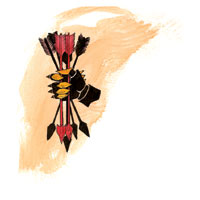 |
|
The Jester, The Keeper of Tales
|
Portfolio:
|
Humor, storytelling, inspiration |
|
Alignment:
|
Chaotic good |
|
Domains:
|
Chaos, Dragon, Good,
Rune, Trickery |
|
Favored Weapon:
|
Shortsword or Claw |
|
Symbol:
|
An open book |
|
Worshipers:
|
Dragons, bards, performers |
|
Home Plane:
|
Arborea |
Hlal is a sleek, copper-colored dragon with a ready grin and
a happy glint in her eye. Of the dragon gods, she is the most
friendly to nondragons (even Aasterinian enjoys a reputation
of playful danger).
Hlal enjoys sharing stories and songs with those who appreciate
such things, regardless of the listener�s race or background.
She has little use for tyrants�even well-meaning
ones�and even less patience for cruelty or bullying. She
teaches that one must be free of restraint, whether real or
psychological, in order to freely express one�s opinions.
Hlal�s clerics are often multiclass cleric/bards, using music,
poetry, and tall tales to spread the faith. Places of worship to
Hlal are usually simple shrines, which can be packed up and
moved to the next town or dragon lair at a moment�s notice.
The followers of Hlal share much in common with those
of Olidammara, and many characters pay homage to both
deities simultaneously. Both Hextor and Vecna are among
her chief enemies, because of their portfolios.
|
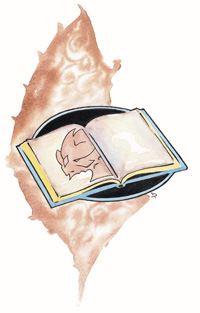 |
|
The Great Brain
|
Portfolio:
|
Mental dominion, magic |
|
Alignment:
|
Lawful Evil |
|
Domains:
|
Evil, Law, Knowledge,
Magic, Mind |
|
Favored Weapon:
|
Tentacle or Unarmed Strike |
|
Symbol:
|
Brain with two tentacles protruding from it |
|
Worshipers:
|
Illithids |
|
Home Plane:
|
Outlands |
Ilsensine is the god of the mind flayers and the patron of all who enslave others’ thoughts. It appears as a massive, disembodied brain with
an emerald glow and countless tentacles stretching off into the darkness. Ilsensine demands that mind flayers enslave and consume the
“cattle” (other races) that surround them. Its clerics provide a measure of healing to mind flayer communities, and they are often
slavemasters, controlling both the living (with psionics) and the undead (with spells and negative energy channeling). Ilsensine’s favored
weapon is the tentacle (or an unarmed strike for followers who aren’t mind flayers).
Ilsensine promises power and dominion to all who follow it, so sometimes creatures other than mind flayers (especially evil psions) will form
cults dedicated to the deity. Ilsensine’s clerics are rare enough that each novitiate learns in a one-on-one apprenticeship with a senior
cleric. A would-be cleric is often treated as little better than a thrall until he proves himself, learning to cast divine spells by imitating his
master.
Ilsensine’s clerics often handle a mind flayer community’s thrall-slaves, and they are also useful for dealing with the undead.
Followers of Ilsensine act as medics for mind flayer hunting parties, sneak onto the surface world to acquire unusual slaves, and match wits against
powerful githyanki and githzerai psions. Ilsensine’s followers pray to her telepathically, holding their tentacles utterly still as a means of
showing respect.
Temples to Ilsensine are generally small, nondescript shrines in an out-of-the-way corner of a mind flayer community. Because most mind flayers
would rather join with the community’s elder brain than serve Ilsensine in the afterlife, religion isn’t central to mind flayer culture.
When a particularly tasty brain is consumed, it’s customary to pray to Ilsensine and use leftover brain ichor to trace Ilsensine’s symbol
(a brain with two tentacles) on a nearby surface.
Ilsensine generally sends a thought slayer as its herald. Its planar allies are succubus demons, cerebriliths, and marilith demons.
|
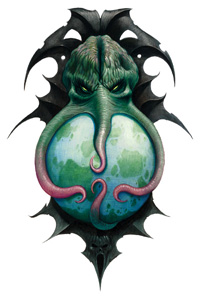 |
|
The Concordant Dragon, The Great Eternal Wheel, Swallower of Shades, The Ninefold Dragon, Creator of Dragonkind
Io the Ninefold Dragon is neutral, for he encompasses
all alignments within his aspects. He can (and does)
appear as any dragon type, from the smallest
pseudodragon to the largest great wyrm.
Io cares only for his �children,� the dragons, and their
continued existence in the world. In some cases, this means
taking the side of the dragons against other races. In other
situations, Io may actually help nondragons fight against a
dragon who would otherwise jeopardize the ongoing survivability
of the species as a whole.
He prefers to remain uninvolved in conflicts between
dragons, though if such a conflict threatens to escalate he
may step in (either personally or by dispatching Aasterinian
or some other servitor).
Io has even fewer clerics or shrines than most of the other
draconic deities, since his outlook is so broad and allencompassing.
Still, even the most devoted cleric of
Bahamut, Tiamat, or any other dragon deity pays at least a
modicum of homage to the Ninefold Dragon. He also
occasionally finds clerics or adepts among the reptilian races,
such as kobolds and troglodytes.
Io counts no other faiths as his
enemies, knowing the value of
neutrality in outlook. Even those
of greatly varying alignment can
find common cause under the banner
of the Ninefold Dragon.
|
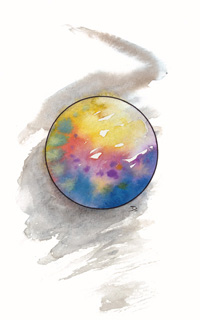 |
|
The Brawler
|
Portfolio:
|
Athletics, sports, brawling, strength, and courage |
|
Alignment:
|
Chaotic Good |
|
Domains:
|
Chaos, Competition, Good, Luck, Strength |
|
Favored Weapon:
|
Greatsword |
|
Symbol:
|
A star of spears and maces |
|
Worshipers:
|
Barbarians, fighters, rogues, athletes |
|
Home Plane:
|
Ysgard |
Kord (kohrd), deity of strength, appears as a hugely muscular man with long red hair and beard, wearing white dragonhide gauntlets, blue boots,
and fighting girdle of red leather. A hedonistic being, he is known for tackling physical challenges of all sorts just for the fun of it. He is also
reputed to have dallied with beautiful humans, elves, or even giants, and tales are told of the great heroes that are born of such liaisons. He
fights with his intelligent dragon-slaying greatsword Kelmar, and when wounded he often enters an intense blood rage.
Kord loves physical challenges and contests, and he promotes nonlethal sports as a method for resolving disputes among his followers. His
teachings say that the strong and fit should lead the weaker, and that bravery is the greatest quality anyone can have, ruler and citizen alike.
Everyone should scorn cowardice, says Kord.
Kord’s clerics are expected to be leaders. They value strength but not domination. They train people to become stronger, organize athletic
tournaments, and participate in challenging physical activities. Doubting their fitness is a grave insult, and they go to great lengths to prove
their physical abilities (although they realize the difference between difficult and suicidal challenges). They favor attire in red and white.
Kord’s temples tend to be spacious and airy. They always include at least one gymnasium and usually extensive baths. They invariably have
adjoining fields for athletic competitions.
|
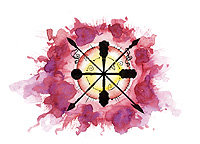 |
Kurtulmak
|
Intermediate Diety
|
Gnomesmasher, The Watcher
|
Portfolio:
|
Kobolds, trapmaking, mining, war |
|
Alignment:
|
Lawful Evil |
|
Domains:
|
Evil, Law, Luck, Trickery |
|
Favored Weapon:
|
Spear |
|
Symbol:
|
Gnome skull |
|
Worshipers:
|
Kobolds |
|
Home Plane:
|
Baator |
Kurtulmak (kurt-uhl-mak), the deity of kobolds, appears as a particularly large kobold. He is about 5 feet tall, with scaly skin mottled black and
green. His ratlike tail is long and tipped with a wicked stinger.
Kurtulmak taught the kobolds the arts of mining, ambushing, and trapmaking. Garl Glittergold, deity of the gnomes, once collapsed
Kurtulmak’s cavernous home as a joke. The event wounded Kurtulmak’s pride on two fronts, as he considered himself both an expert
trickster and a miner without equal. Since then Kurtulmak has hated Garl and all gnomes. Kurtulmak hates being bettered by any means, especially by
some frivolous method such as an illusion or a practical joke. He carries grudges and has a huge chip on his small shoulder.
Kurtulmak is a savage deity who is always attentive to events on the Material Plane and eager to secure any advantage for his people. He teaches
the kobolds that fair fights are for fools or for the unlucky. It is better to flee and fight again than to be defeated, and no fight is truly over
if even one kobold lives. Revenge is sweet, says Kurtulmak, even if it takes years to arrange. Kurtulmak also teaches his people that a quick wit, a
good plan, and a well-laid ambush are far better than a strong sword arm.
Kurtulmak’s clerics lead war and raiding parties, see to tribal defense (especially the construction of traps), and oversee each
tribe’s mining operations. Others lead expeditions to explore new areas and probe dwarf and gnome settlements for weaknesses the kobolds can
exploit.
No kobold community is complete without a temple or shrine to Kurtulmak. They are usually dug out of solid rock and accessed through narrow,
twisting passages guarded by traps. Inside, a temple to Kurtulmak is cramped and usually decorated with piles of gnome skulls.
|
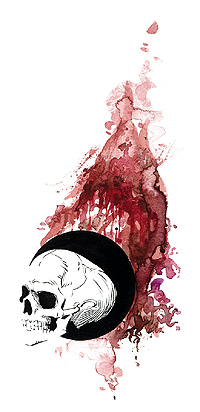 |
|
Scale of Justice, The Balancer, Weigher of Lives
|
Portfolio:
|
Balance, justice |
|
Alignment:
|
Lawful neutral |
|
Domains:
|
Destruction, Dragon,
Law, Protection,
Retribution |
|
Favored Weapon:
|
|
|
Symbol:
|
Sword balanced on a needle�s point |
|
Worshipers:
|
Dragons |
|
Home Plane:
|
Mechanus |
Unlike Chronepsis, who judges the
life of a dragon only after its death,
Lendys metes out justice during
a dragon�s life. His scales are a
tarnished silver, some say
because he cares more about
judging others than tending
to himself.
Lendys is the arbiter of dragonkind, serving as judge, jury, and
executioner alike. When a
dragon has committed an injustice against dragonkind, Lendys
(or one of his trio of great wyrm
silver dragons) is dispatched to deal
out appropriate justice. Punishments
are severe, and appeals unheard of.
The clerics and paladins of Lendys are
justice-bringers as well, often serving as
arbiters for local communities. In some cases,
towns even rely on the local draconic worshiper of Lendys
to parse out justice.
Clerics of Lendys get along well with worshipers of St.
Cuthbert, and poorly with those who follow a chaotic deity
such as Kord, Olidammara, or Erythnul.
|
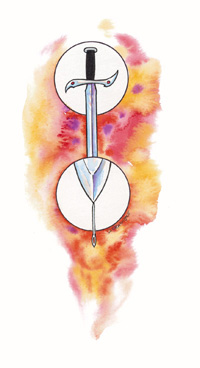 |
|
Queen of the Drow, The Spider Goddess, Queen of the Demonweb Pits
|
Portfolio:
|
Drow, spiders, evil, darkness |
|
Alignment:
|
Chaotic Evil |
|
Domains:
|
Chaos, Destruction, Evil, Trickery |
|
Favored Weapon:
|
Whip |
|
Symbol:
|
Black spider with the head of a drow female |
|
Worshipers:
|
Drow |
|
Home Plane:
|
The Abyss |
Lolth (lohlth) appears as either a tall, beautiful female drow or as a black spider with a female drow’s head. She maintains a ruthless,
tyrannical reign over the drow, ruling through a combination of fear and the promise of power.
It was Lolth who first spread evil among the elves, and it was she who led the drow to break away from the rest of elven society and to dwell
underground. Drow scoff at any attempt to suggest that they were banished from the surface. Nevertheless, Lolth has sworn vengeance against Corellon
Larethian and his people.
Lolth constantly turns one drow against another. She claims to do this to cull out the weak and to make the race strong, but she is a cruel and
capricious deity who enjoys watching others suffer. She is careful to prevent open or widespread strife among the drow. She does not tolerate
campaigns of harassment or attrition among groups of drow, but she does sanction well-planned, swift, and overwhelming attacks.
Lolth expects her people to be shrewd, calculating, and aware of the dangers and opportunities around them. She has no use for sentiment,
weakness, or love. She expects her people to rule the entire Underdark (the realm beneath the surface of the earth), eliminating foes that are weak
enough to be destroyed and biding their time before attacking other opponents. She also expects them to eventually invade and conquer the surface,
not to colonize it but to defeat Corellon Larethian and the surface elves.
Lolth rules her people through her clerics, who are exclusively female and organized into noble houses made up of clerics related by blood. The
oldest clerics rule the house, with younger clerics following in order by age. Each house also includes noncleric drow related by blood or marriage.
The clerics serve as absolute rulers in Lolth’s name. They are the leaders, police, juries, and executioners of drow society.
Nearly every drow home has at least a small shrine to Lolth, even if it is just a spider statue or modest altar. Larger temples to Lolth are
usually laid out in the shape of a spider. They serve as meeting places, sacrificial sites, and centers of entertainment for high-ranking drow.
|
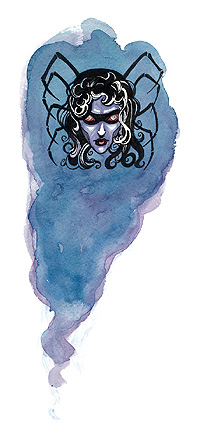 |
|
The Soul Forger, Dwarffather, The All-Father, The Creator
|
Portfolio:
|
Dwarves, creation, smithing, engineering, war |
|
Alignment:
|
Lawful Good |
|
Domains:
|
Creation, Earth, Good,
Law, Protection |
|
Favored Weapon:
|
Warhammer |
|
Symbol:
|
Hammer and anvil |
|
Worshipers:
|
Dwarves, metal-workers |
|
Home Plane:
|
Celestia |
The deity of dwarves, Moradin (moar-uh-din), usually appears as a stern-faced male dwarf with a powerful build. His upper body is particularly
robust, with a barrel chest, wide shoulders, and arms corded with big muscles. He has flowing black hair and a beard to match, and he always wears
full plate armor. He carries a shield and a warhammer. Moradin forged the first dwarves out of metal and gems and breathed life into them.
Moradin is an adamant defender of the dwarven people he created and of the principles of law and good. He teaches the value of making goods that
last, of loyalty to clan, leader, and people, and of meeting adversity with stoicism and tenacity. He tolerates no taint of evil among the dwarves;
it was he who drove the derro and duergar out of the dwarven community. It is Moradin’s influence that leads the dwarves toward excellence in
craftwork and staunch defense of what is theirs.
Clerics of Moradin are charged with maintaining and advancing the dwarven race in all walks of life. They perform a wide range of public
ceremonies (marriages, blessing new ventures, crowning monarchs, and the like). They also educate the young, arrange communal defenses, and sponsor
expeditions to settle new lands. They also keep detailed genealogies and historical archives.
Every temple or shrine of Moradin includes an anvil and a forge that the clerics keep perpetually burning. The anvil can be a simple decoration or
part of a working smithy, but it often serves as the temple altar.
|
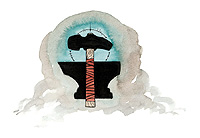 |
|
The Reaper, The Foe of All Good, Hater of Life, Bringer of Darkness, King of All Gloom, Reaper of Flesh
|
Portfolio:
|
Death, darkness, murder and the underworld |
|
Alignment:
|
Neutral Evil |
|
Domains:
|
Death, Evil, Fate, Pestilence,
Trickery |
|
Favored Weapon:
|
Scythe |
|
Symbol:
|
Skull and scythe |
|
Worshipers:
|
Necromancers, assassins, rogues, murderers |
|
Home Plane:
|
Carceri |
The deity of death, Nerull (nare-ull), is widely known and widely feared. His gaunt form resembles a mummified, nearly skeletal corpse with rusty
red skin, thick blackish-green hair, a cowled cloak of rusty black, and eyes, teeth, and nails like poisonous verdigris. His black staff, Lifecutter,
forms a scythelike blade of red force that slays anyone it touches.
Nerull is the patron of those who seek the greatest evil for their own enjoyment or gain.
All are equal in Nerull’s cold realm. Every living thing is an affront to the Reaper, and every death brings a dark spark of joy to his
long-dead heart. Those that pray to Nerull to appease him only attract his attention and their own doom. Those that kill in his name shall be
rewarded (or so Nerull promises).
Clerics of Nerull are secretive and solitary, since few sane people tolerate their presence. Except in the most evil lands, Nerull has no
organized churches. With no overall hierarchy, individual churches work against each other at times. Still, the Reaper is feared across the lands.
His clerics wear rust-red garb when not in disguise. Nerull’s clerics commit murders as offerings to their deity. If their actions are
discovered, they move on to new hunting grounds. Some take up the wandering life and put on innocent faces as they move from town to town, murdering
a few people and then moving on.
Temples to Nerull are always hidden, even in lands where the Reaper is honored. They usually are located underground, often as parts of catacomb
complexes. Most temples are stocked with undead creatures and others that spread or celebrate death, such as hags, fiends, and vargouilles.
|
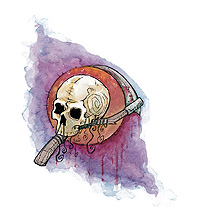 |
Obad-Hai
|
Intermediate Diety
|
The Shalm
|
Portfolio:
|
Nature, freedom, hunting, and beasts |
|
Alignment:
|
True Neutral |
|
Domains:
|
Air, Animal, Earth, Fate, Fire, Plant, Water, Weather, |
|
Favored Weapon:
|
Quarterstaff |
|
Symbol:
|
Mask of oak leaves and acorns |
|
Worshipers:
|
Barbarians, rangers, druids, hunters |
|
Home Plane:
|
Outlands |
Obad-Hai (oh-bod-high), deity of nature, is most often shown as a lean and weathered man of indeterminately old age, dressed in brown or russet
and looking like a hermit, although nonhuman communities depict him as one of their own race. Because Obad-Hai strictly adheres to neutrality, he is
a rival of Ehlonna. Obad-Hai plays a shalm (a double-reed woodwind musical instrument, also spelled “shawm”) and takes his title from
this instrument. He also carries a staff.
Obad-Hai rules nature and the wilderness, and he is a friend to all who live in harmony with the natural world. He expects his followers to live
in harmony with nature in all its variety. Those who destroy or otherwise harm nature deserve swift vengeance in an appropriate manner, says
Obad-Hai. Those who are one with nature, however, have little to fear, although the well-meaning but foolish are sometimes brought down by a danger
they could not avoid or divert.
Obad-Hai teaches that the wilds can sometimes be ugly, dangerous, or terrible, but that these things are a part of nature and should be respected
as much as those that are beautiful, harmless, or wonderful, for these characterizations mark a newcomer’s perspective.
Clerics of Obad-Hai have no hierarchy. They treat all those of their order as equals. They wear russet-colored clothing and maintain hidden
woodland shrines that are usually located far from civilization. They keep to the wilderness and to themselves, rarely getting involved in
society.
A wide variety of peoples serve as Obad-Hai’s clerics, including humans, gnomes, halflings, and sylvan fey. They serve as protectors of
nature, acting as the agents of retribution when their protection is insufficient or too late.
Temples to Obad-Hai can be located nearly anywhere but are usually located amid groves of oak trees.
|
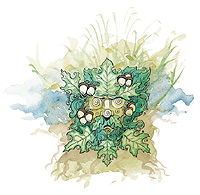 |
Olidammara
|
Intermediate Diety
|
The Laughing Rogue
|
Portfolio:
|
Music, revels, wine, rogues, humor, and tricks |
|
Alignment:
|
Chaotic Neutral |
|
Domains:
|
Celerity, City, Chaos, Luck
Mind, Trickery |
|
Favored Weapon:
|
Rapier |
|
Symbol:
|
Laughing mask |
|
Worshipers:
|
Rogues, bards, actors, vintners |
|
Home Plane:
|
Ysgard |
The deity of rogues, Olidammara (oh-lih-duh-mar-uh), most often appears as a brown-haired man of rakish appearance, olive skin, and merry eyes,
but he often goes incognito. Olidammara delights in wine, women, and song. He is a vagabond, a prankster, and a master of disguise. His temples are
few, but many people are willing to raise a glass in his honor.
Olidammara loves upsetting anyone who seems too attached to an ordered life and a predictable routine. He urges his followers to bend every effort
toward mastering the art of music. He also teaches that life is meant to be happy and entertaining, and the best jokes need a target to hang them on.
The tables can turn on any trickster, and Olidammara’s followers should accept the laugh and appreciate the trick when it happens to them.
Wine, Olidammara says, is one of the joys of life, and the only thing better than making wine is drinking it. Avoid misery, temperance, and
solemnity, for they are the greatest poisons to the soul.
Olidammara’s religion is loosely organized, but his clerics are numerous. They usually work among urban folk or wander the countryside.
Olidammara’s clerics often have a second occupation, such as minstrels, brewers, or jacks-of-all-trades. Thus, they can be found almost
anywhere doing or wearing anything.
Temples dedicated solely to Olidammara are few. But as his followers say, there is a temple of Olidammara anywhere there is wine, song, and
laughter, Most formal temples of Olidammara are hidden, because they usually double as hideouts for thieves. Many drinking establishments include at
least small shrines to Olidammara.
|
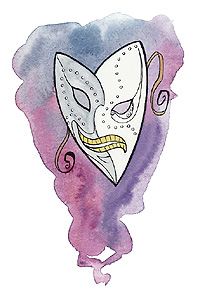 |
|
Demon Prince of the Undead, Tenebrous
|
Portfolio:
|
Undeath, revenge |
|
Alignment:
|
Chaotic Evil |
|
Domains:
|
Chaos, Evil, Death, Darkness |
|
Favored Weapon:
|
Mace |
|
Symbol:
|
Skull-headed rod |
|
Worshipers:
|
Demons, necromancers, and the undead |
|
Home Plane:
|
Abyss |
Orcus is a massive, bloated demon prince—bloated on spite, bile, and contempt. Once complacent, his wars against Demogorgon and
Graz’zt waning, he was murdered and deposed. But then Orcus rose from the dead as an undead demon and took the name Tenebrous, hiding in the
shadows, waiting to take his revenge. Now he has reinstated himself in his former position and taken up residence in Naratyr, his terrible
fortress-city in the Abyss on Thanatos (the layer he rules). Once again, he finds himself in a struggle for dominance with many of the other demon
lords. He is no longer content to grow old and fat feeding on larvae in his castle. Orcus lives in the Abyss. His symbol is a skull-headed rod.
Orcus appeals most to demons, necromancers, and the undead. While not an actual god quite yet, Orcus is worshiped as a god more often than any of
the other demon princes. Although Demogorgon might actually be more powerful, Orcus is closer to ascending to true godhood. The cult of Orcus is
widespread among other groups as well, with a more significant following among humanoids than most demon princes. In particular, orcs, half-orcs,
ogres, and giants revere Orcus, as well as corrupt and despicable humans.
Orcus is, in many ways, a contradictory figure. He does not delight in his charges, the undead, and has not taken up the selfproclaimed mantle of
“Prince of the Undead” out of devotion or allegiance. If anything, the demon lord despises the undead—he has little but contempt
for them and uses them without thought or consideration. Of course, Orcus despises the living as well. He hates everything and everyone, often being
almost overwhelmed with revulsion and loathing. He craves only personal power and the spread of misery and destruction for all others.
Orcus isn’t one for orderly training or organization, so neither are his priests. Thus, training consists of little more than a grisly oath,
the introduction to the mythology of Orcus, and a hearty strike with a skullheaded rod to complete the process. Orcus has set his worshipers the task
of increasing the level of his own worship across all lands, killing those who resist—including the followers of other evil deities, especially
Nerull. Typical quests include attacking a rival Nerull-cultist compound, raiding a church of Pelor to destroy its sacred items, and building or
opening portals or gates from the Abyss to the Material Plane. The most common refrain in a prayer to Orcus is a confirmatory phrase at the end of a
declaration, something like “. . . or let Orcus strike me dead and steal my eternal soul.”
Despite his status as a demon prince rather than a true god, Orcus has inspired the creation of temples all over the planes. Those that worship
him gain clerical power as if worshiping a true deity, though they clearly gain that power from some more universal source (perhaps from the Negative
Energy Plane itself). His temples are usually hidden, while his worshipers function as secret societies living in otherwise normal communities. Other
temples, however, are terrible strongholds full of undead, where wicked lords commit atrocities and wage wars in the demon prince’s name.
Sometimes an entire orc tribe devotes itself to the Prince of the Undead, but these individuals are shunned even by other orcs.
Bloody conflict is the method that Orcus’s followers use to rise in the ranks. Sometimes this activity is formalized, as when underlings
challenge upper-echelon clerics according to the Rite of Challenge. Of course, this usually results in the underlings’ death before the Rite of
Challenge can properly occur. In fact, the Rite of Challenge may just be a way for high-level clerics to identify troublemakers and weed them from
the flock.
A balor is Orcus’s favorite choice for herald. Planar allies include howlers, glabrezu demons, and nalfeshnee demons.
|
 |
|
The Shining One
|
Portfolio:
|
Sun, light, strength and healing |
|
Alignment:
|
Neutral Good |
|
Domains:
|
Glory, Good, Healing, Nobility,
Strength, Sun |
|
Favored Weapon:
|
Mace |
|
Symbol:
|
Sun face |
|
Worshipers:
|
Bards, rangers, druids, healers, commoners |
|
Home Plane:
|
Elysium |
Pelor (pay-lore), deity of the sun, is depicted as an older man in white, with wild hair and a beard of shining gold. Pelor is the creator of many
good things, a supporter of those in need, and an adversary of all that is evil. He is the most commonly worshiped deity among ordinary humans, and
his priests are well received wherever they go.
Though widely revered as a peaceful and gentle deity who alleviates suffering, Pelor also has more martial aspects. He brings his wrath to bear on
darkness and evil, and he invigorates and heals those who champion the cause of good.
Pelor teaches that the energy of life originates from the sun. This light brings strength to the weak and health to the injured, while destroying
darkness and evil. He urges his followers to challenge the forces of corruption aggressively, but also to remember that just as staring at the sun
can cause blindness of the eyes, relentless attention to the destruction of negative forces can blind the heart to the true essentials of life:
kindness, mercy, and compassion.
Pelor’s clerics favor yellow garb. They are usually kindly people with backbones of steel. They are primarily nurturers and protectors, but
when the time comes to bear arms they are not afraid to do so. They use their powers to heal, nourish, and otherwise aid the needy, while practicing
the skills needed to protect their charges should they be threatened. Many clerics of Pelor leave their pastoral duties and go to explore far lands
in an effort to drive off harmful beings and spread their deity’s gifts to all who need them.
Temples to Pelor tend to be tall, airy, and blindingly white. They are usually placed so the sun shines into most of their rooms throughout the
day. They often feature open, sunny courtyards as well. Pelor’s temples are always kept scrupulously clean, and many of them of have wings that
house hospitals.
|
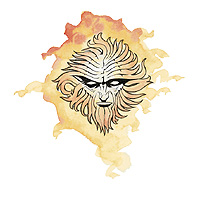 |
St. Cuthbert
|
Intermediate Diety
|
St. Cuthbert of the Cudgel
|
Portfolio:
|
Common sense, wisdom, zeal, honesty, truth, and discipline |
|
Alignment:
|
Lawful Neutral |
|
Domains:
|
Destruction, Domination, Law, Protection, Strength |
|
Favored Weapon:
|
Mace |
|
Symbol:
|
Ruby-studded starburst |
|
Worshipers:
|
Fighters, monks, judges, constables |
|
Home Plane:
|
Arcadia |
The deity of retribution, St. Cuthbert (saint cuhth-burt), takes many forms. He often masquerades as a common yokel or whitehaired, mustached man
in plate mail. He usually carries his famous mace.
St. Cuthbert exacts revenge and just punishment on those who transgress the law. Becauseevil creatures more commonly and flagrantly violate laws
than good creatures do, St. Cuthbert favors good over evil, though he is not good himself. He may have once been a mortal man (as his worshipers
claim), but if so it was long ago and from an unknown branch of humanity.
The words of St. Cuthbert are wise, practical, and sensible. Among his followers, the Word of the Cudgel is law, and his followers take pains to
spread the word so that may all may benefit from St. Cuthbert’s wisdom. Weakness in faith and acting against the Saint’s teachings are
intolerable, especially in believers. St. Cuthbert exhorts his followers to make increasing efforts to bring unbelievers into the fold. Honesty,
truthfulness, practicality, and reasonability are the highest virtues, says St. Cuthbert.
Clerics of the Cudgel are stern folk who speak their minds plainly. They do not suffer fools and disapprove of those who backslide in faith. They
train in the arts of war and keep themselves physically fit. Many serve as constables, detectives, judges, and bounty hunters.
Temples of St. Cuthbert are always solid and imposing. Their entrances or facades invariably feature inscriptions of quotations attributed to the
Cudgel. These can be inspirational, such as:“Chaos and evil prevail where good folk do nothing.” Or even threatening, such as:
“Obstinacy brings lumps to the heads of the unfaithful.”
|
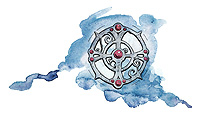 |
|
Her Beneficence, Her Mercy
|
Portfolio:
|
Life, light, mercy |
|
Alignment:
|
Neutral good |
|
Domains:
|
Dragon, Family, Good, Healing, Strength, Sun |
|
Favored Weapon:
|
Scimitar or Claw |
|
Symbol:
|
Seven-pointed star on field of black |
|
Worshipers:
|
Good dragons, healers, those desiring mercy |
|
Home Plane:
|
Elysium |
Tamara is the kindest and most
benevolent of the draconic deities.
Some mistake this quality for weakness, though such beings don�t
make the same error twice. She
appears as a luminously beautiful
silver dragon, her eyes shining with
the brightness of the sun itself.
Tamara believes in mercy, both in life
and in death. Not only does she heal the
sick and tend the injured, she delivers a
merciful end to those dragons nearing the
end of their natural lives. She fiercely detests
those who artificially prolong the life of a
dragon, particularly when it is against that dragon�s will.
Tamara�s clerics are healers, but also deliverers of death to
those who try to escape it. They prefer to destroy any undead they
encounter, particularly draconic undead (such
as dracoliches).
Though a peaceful and merciful faith, the worshipers of
Tamara do not hesitate to stand against evil or tyranny.
Tamara counts Pelor among her staunchest allies and Falazure,
Hextor, Nerull, and Erythnul among her enemies.
|
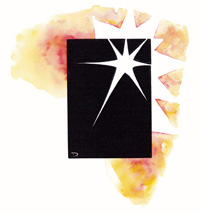 |
|
The Chromatic Dragon, Queen of the Evil Dragons
|
Portfolio:
|
Evil dragons, conquest |
|
Alignment:
|
Lawful Evil |
|
Domains:
|
Destruction, Dragon,
Evil, Greed, Hatred,
Law, Skalykind, Tyranny,
Trickery |
|
Favored Weapon:
|
Heavy pick or Claw |
|
Symbol:
|
Five-headed dragon |
|
Worshipers:
|
Evil dragons, conquerors |
|
Home Plane:
|
Baator |
Tiamat (tee-ah-mat), like her archrival, Bahamut, is revered as a deity in many locales. All evil dragons pay homage to Tiamat; green and blue
dragonsacknowledge her sovereignty the most readily. Good dragons have a healthy respect for Tiamat, though they usually avoid mentioning her or even
thinking about her.
In her natural form, Tiamat is a thick-bodied dragon with five heads and a wyvern’s tail. Each head is a different color: white, black,
green, blue, and red. Her massive body is striped in those colors.
Tiamat has many consorts, include great wyrm dragons of the white, black, green, blue, and red types.
Tiamat concerns herself with spreading evil, defeating good, and propagating evil dragons. She enjoys razing the occasional village, city, or
country, but only as a diversion from her subtle, worldspanning plots. She is the villain who lurks in the shadows. Her presence is felt but seldom
seen.
Tiamat constantly seeks to extend the power and dominion of evil dragons over the land, particularly when her subjects find themselves embroiled
in territorial disputes with good dragons. Tiamat also unfailingly demands reverence, homage, and tribute from her subjects.
Like Bahamut, Tiamat has few clerics and even fewer temples. She accepts only evil clerics. Tiamat’s clerics, like Tiamat herself, seek to
place the world under the domination of evil dragons.
Though most evil dragons honor Tiamat, few keep shrines dedicated to her in their lairs because they don’t want Tiamat’s greedy eyes
gazing at their treasure hoards. Instead, they dedicate vast, gloomy caverns to their deity and keep them stocked with treasure and sacrifices.
|
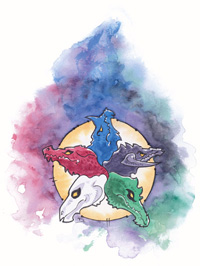 |
|
The Maimed Lord, The Whispered One, The Master of All That Is Secret and Hidden
|
Portfolio:
|
Destructive and evil secrets |
|
Alignment:
|
Neutral Evil |
|
Domains:
|
Destiny, Evil, Knowledge, Madness, Magic, Planning, Tyranny, |
|
Favored Weapon:
|
Dagger |
|
Symbol:
|
Left hand clutching an eyeball |
|
Worshipers:
|
Wizards, sorcerers, conspirators |
|
Home Plane:
|
Material Plane |
Vecna (veck-nuh), deity of secrets, was once a mortal king who became a lich. He usually appears as a lich who is missing his left hand and left
eye. He lost his hand and eye in a fight with his traitorous lieutenant, Kas. Vecna rules that which is not meant to be known and that which people
wish to keep secret.
Vecna plots the destruction of the other deities so that he may take the world for himself.
According to Vecna, there exists a secret that can destroy any being, no matter how powerful that being is. In the middle of every heart hides a
seed of darkness kept hidden from all but the self. Finding that secret evil and exploiting it is the key to undoing one’s enemies. Strength
and power, says Vecna, come from knowing and controlling what others do not. He also admonishes his followers never to reveal all that they know.
Vecna’s clerics subvert governments, seduce good folk to evil, and plot the eventual control of the world. Naturally, these plans mean that
their lives are forfeit if they are discovered, and they are very secretive to prevent this. They can be found in any part of the world, spreading
evil or looking for documents or items that date back to their master’s ancient empire. Of particular interest are their master’s relics
(his hand and eye), which have once againbeen lost. Black and red are their favored colors.
Vecna’s priesthood is made up of isolated cells of cultists who seek dark, arcane secrets to further their evil schemes. Temples to Vecna
serve as bases and safe houses for his clerics. They are always well hidden and warded against unauthorized entry. They usually also include vast
archivesof information, secrets that Vecna’s clerics have uncovered over the centuries.
|
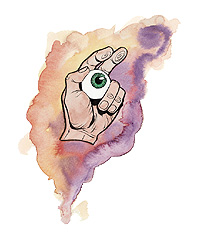 |
|
The Witch Goddess, The Ruby Sorceress, The Stern Lady, Death’s Guardian
|
Portfolio:
|
Magic, death, vanity, and law |
|
Alignment:
|
Lawful Neutral |
|
Domains:
|
Death, Domination, Law,
Magic, Mind, Planning, Tyranny |
|
Favored Weapon:
|
Dagger |
|
Symbol:
|
Red skull wreathed in flame |
|
Worshipers:
|
Necromancers, wizards |
|
Home Plane:
|
Acheron |
Wee Jas (wee jass), deity of death and magic, is most often portrayed as a stunning woman dressed in a beautiful gown, wearing some piece of
jewelry with a skull motif. Wee Jas is a demanding deity who expects obedience from her followers. She respects Boccob, but the two do not have an
alliance.
Wee Jas promotes using spells and magic items (though many of her followers insist she favors the creation of such things).
Wee Jas tells her followers that magic is the key to all things. Wee Jas promises that understanding, personal power, security, order, and control
over fate come with the study of magic. She admonishes her followers to respect those who came before, because they left their knowledge and died to
make room for them. She reminds them that death is inevitable, but she promises that their learning and memory will be honored by those who come
after.
Wee Jas’s priesthood has a strict h
ierarchy. Her clerics are known for their discipline and obedience to their superiors. Clerics of Wee Jas arbitrate disputes, give advice on magic,
investigate magical curiosities, create magic items, and administer funerals. Clerics of lower level are expected to defer to ones of higher level at
all times. They wear black or gray robes.
Temples to Wee Jas are few and far between, but she counts many powerful sorcerers and wizards (especially necromancers) among her worshipers.
Most of her temples are located in or near graveyards or catacombs, and they always contain crypts where powerful wizards are buried. They also
contain extensive libraries of arcane lore and large collections of items that once belonged to great wizards from past eras.
|
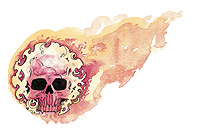 |
|
The Protector and Provider, The Nurturing Matriarch, The Blessed One
|
Portfolio:
|
Halflings, protection, fertility |
|
Alignment:
|
Lawful Good |
|
Domains:
|
Community, Courage, Creation, Good, Law, Protection |
|
Favored Weapon:
|
Short sword |
|
Symbol:
|
Shield bearing cornucopia |
|
Worshipers:
|
Halflings, explorers, pioneers |
|
Home Plane:
|
Celestia |
The deity of halflings, Yondalla (yon-dah-lah), appears as a strong female halfling, with a proud bearing. She dresses in green, yellow, and
brown, and always carries a shield. Yondalla is the creator and protector of the halfling race.
Yondalla espouses harmony within the halfling race and stalwart defense against its enemies. She urges her people to work with others but to
remain true to their halfling heritage. Most halflings heed this advice, which allows them to form close-knit enclaves where halflings are welcomed,
even when they have settled in areas where other creatures predominate. Yondalla also teaches that opportunities are there to be seized, which leads
most halflings to be both adaptable and somewhat opportunistic. Yondalla brooks no evil among halflings, but she does not despise any halfling.
Rather, she seeks to guide halflings who have lost their way back to their homes and friends.
Clerics of Yondalla are concerned with all areas of halfling life, except for thievery. (Thievery arises among halflings, the clerics say, from a
too-liberal interpretation of Yondalla’s advice about seizing opportunities.) Yondalla’s clerics officiate at weddings and funerals,
bless crops and new ventures, and lay plans for community defense.
Temples dedicated to Yondalla are often set amid bountiful gardens or farm fields. They always contain storehouses stuffed with food and other
necessities, They also contain armories and fortified sections where local halflings can safely ride out natural disasters or enemy attack.
|
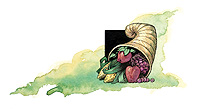 |
|
Master of Da'Shon and Edel, Servant of the Lady, the Survivor
|
Portfolio:
|
Monks, mental powers. |
|
Alignment:
|
True Neutral |
|
Domains:
|
Knowledge, Mind, Strength, War |
|
Favored Weapon:
|
Nunchaku |
|
Symbol:
|
Striking Fist |
|
Worshipers:
|
Monks, Psions |
|
Home Plane:
|
Prime Material |
Once a human martial artist, Zuoken attained such mental and physical perfection that he ascended into godhood several centuries ago. His clerics
watch over psionic creatures, safeguarding them from harm and offering psionic training to all who show aptitude. Zuoken encourages his followers to
be disciplined, serene masters of their minds and bodies. His symbol is a striking fist, and his favored weapon is the nunchaku.
Zuoken’s followers study his harmonious philosophies at the foot of a master, often in a monastery far from civilization. Training consists
of long dialogues between master and students, punctuated by rigorous practice sessions and physical conditioning. Zuoken sends his followers into
the world to improve themselves and advance the cause of psionics. Typical missions include rescuing a psionic family from superstitious villagers,
hunting down a mind flayer assassin with a taste for psion brains, and finding a longlost psionic artifact known as the Orb of Gerendelik.
Prayers to Zuoken are short and poetic, and many use strange sentence structure, mixing up the words in a way confusing to nonbelievers. A common
beginning to a prayer is “Zuoken, me to the pinnacle take . . .” Zuoken’s monasteries are generally far from civilization, but
because they serve as psionic training centers, their locations are not secret. Many temples are guarded by an order of monks, the Fists of Zuoken,
who are drawn by the demigod’s serene philosophy.
The followers of Zuoken make a point of meditating at every full moon, because it is said that Zuoken himself ascended to godhood by climbing a
silvery staircase to the moon. Zuoken generally sends a thought slayer as his herald. His planar allies are rasts, couatls, and Huge elementals of
any kind.
|
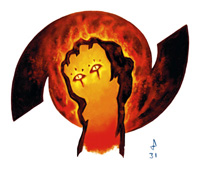 |
|





































